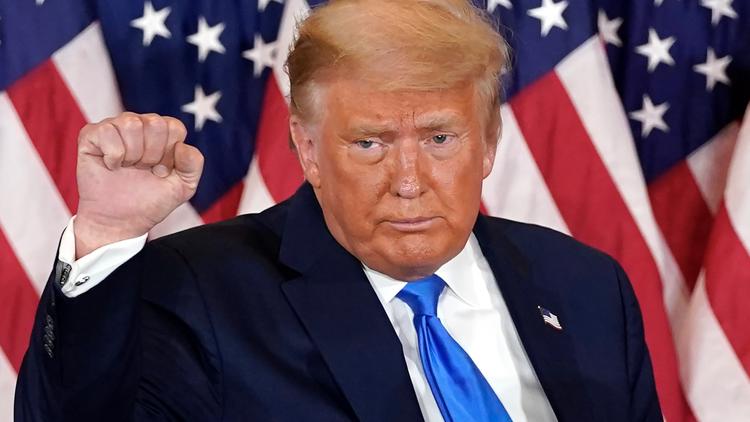WASHINGTON, D.C., USA — Let the Trump Trade Wars 2.0 begin! If you're a Hoosier farmer or auto worker, brace yourselves for potential impacts and bailouts.
On Tuesday, President-elect Donald J. Trump announced huge tariffs aimed at our three biggest trade partners, Mexico, Canada and China. There is now intense speculation that these three nations will retaliate.
“On January 20th, as one of my many first Executive Orders, I will sign all necessary documents to charge Mexico and Canada a 25% Tariff on ALL products coming into the United States, and its ridiculous Open Borders,” Trump posted on his Truth Social platform. “This Tariff will remain in effect until such time as Drugs, in particular Fentanyl, and all Illegal Aliens stop this Invasion of our Country!”
Trump allies see these tariffs as potential bargaining chip. “I think Trump is a world-class negotiator, and I’m confident that he’ll support the U.S. agriculture economy,” Kip Tom, a Kosciusko County farmer and co-chair of the Farmers and Ranchers for Trump 47, told Hoosier Ag Today.
U.S. Trade Representative data reveals that Indiana exported $56 billion, with 27% ($14.9 billion) to Canada, $7.5 billion to Mexico and $5 billion to China in 2022. According to Hoosier Ag Today, Indiana is the seventh largest agriculture exporting state shipping $7.4 billion in domestic exports abroad in 2022, according to United States Department of Agriculture. That same year, Indiana exported $2.6 billion in soybeans, $1.3 billion in corn, $836 million in feeds and other feed grains, $472 million in soybean meal, and $394 million in pork.
According to Autos Drive America, Indiana produced 948,130 vehicles in 2023, generating 124,135 jobs (and another 97,813 in indirect employment) while making $9.4 billion in employee compensation. It's a $19 billion industry producing 3.8% of Indiana's gross state product.
The proposed tariffs and Trump's threat to pull electric vehicle tax credits could change the playing field at a time when General Motors and Samsung are building a $3.5 billion battery plant near New Carlisle. This project has already been delayed by a year due to what the Associated Press described as slowing EV sales in the U.S.
This is a repeat from Trump's playbook after he imposed similar tariffs in 2018 in 2019.
The Tax Foundation described those tariffs as "tax increases" on American consumers, despite Trump's assertion that China would be paying.
"The Trump administration imposed nearly $80 billion worth of new taxes on Americans by levying tariffs on thousands of products valued at approximately $380 billion in 2018 and 2019, amounting to one of the largest tax increases in decades," the Tax Foundation observed. The Biden administration has kept most of the Trump tariffs in place, and in May 2024, announced tariff hikes on an additional $18 billion of Chinese goods, including semiconductors and electric vehicles, for an additional tax increase of $3.6 billion.
"We estimate the Trump-Biden tariffs will reduce long-run GDP by 0.2%, the capital stock by 0.1%, and employment by 142,000 full-time equivalent jobs," the Tax Foundation said.
The impact of Trump's initial tariffs on U.S. households had been about $625 a year. "If imposed permanently, we estimate these tariffs would generate $1.2 trillion in tax revenue from 2025 through 2034 on a conventional basis," the Foundation added. "In the long run, we estimate the tariffs would reduce GDP by 0.4% and employment by 344,900 jobs. Our estimates do not capture the effects of retaliation, nor the additional harms that would stem from starting a global trade war."
According to Agriculture Dive, "Higher tariffs could further erode market opportunities for farmers as they struggle to compete with lower-priced commodities from other countries. If China were to retaliate with its own 60% tariffs on U.S. farm goods, it would result in a loss of 25 million metric tons of soybean exports and 90% of corn exports, according to a study commissioned by National Corn Growers Association and American Soybean Association.
“Bottom line: A repeated tariff-based approach accelerates conversion of cropland in South America, which has permanent ramifications on soybean and corn exports worldwide,” the trade groups said following the release of the study, completed by the World Agricultural Economic and Environmental Services. “And U.S. soybean and corn growers bear the burden.”
As for Hoosier farmers, the Trump tariffs were damaging, and he responded by creating Market Facilitation Payments, the USDA's program for farmers whose access to the Chinese market has been cut off.
According to Politico, direct farm aid climbed each year of Trump’s first presidency, from $11.5 billion in 2017 to more than $32 billion 2020. The New York Times reported that in 2020, Market Facilitation Payments reached $46 billion that election year.
For contrast, the Bush43 and Obama administrations bailed out GM and Chrysler in 2008-10 to the tune of $80 billion. Moody's chief economist Mark Zandi told Marketplace that all but $9 billion had been repaid.
Politically, these federal bailout funds proved to be advantageous for the Trump campaign, as he carried most rural Indiana counties with 65% to 75% of the vote in 2020 and again on Nov. 5.
But the reality is that these bailout funds simply end up on the federal credit card, to be paid (or endured) by future generations.
Howey is a senior writer for Howey Politics Indiana and State Affairs. Find Howey on X @hwypol.



